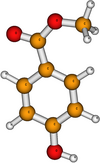This is an old revision of this page, as edited by Beetstra (talk | contribs) at 10:56, 25 February 2011 (Script assisted update of identifiers from ChemSpider, CommonChemistry and FDA for the Chem/Drugbox validation project - Updated: ChEMBL KEGG.). The present address (URL) is a permanent link to this revision, which may differ significantly from the current revision.
Revision as of 10:56, 25 February 2011 by Beetstra (talk | contribs) (Script assisted update of identifiers from ChemSpider, CommonChemistry and FDA for the Chem/Drugbox validation project - Updated: ChEMBL KEGG.)(diff) ← Previous revision | Latest revision (diff) | Newer revision → (diff) This article is about this particular compound. For the class of hydroxybenzoate esters, including discussion on possible health effects, see paraben.
| |||
| Names | |||
|---|---|---|---|
| IUPAC name Methyl 4-hydroxybenzoate | |||
| Other names
Methyl paraben; Methyl p-hydroxybenzoate; Methyl parahydroxybenzoate; Nipagin M; E number E218; Tegosept; Mycocten | |||
| Identifiers | |||
| CAS Number | |||
| 3D model (JSmol) | |||
| ChEMBL | |||
| ChemSpider | |||
| ECHA InfoCard | 100.002.532 | ||
| E number | E218 (preservatives) | ||
| KEGG | |||
| PubChem CID | |||
| UNII | |||
| CompTox Dashboard (EPA) | |||
InChI
| |||
SMILES
| |||
| Properties | |||
| Chemical formula | C8H8O3 | ||
| Molar mass | 152.149 g·mol | ||
| Related compounds | |||
| Except where otherwise noted, data are given for materials in their standard state (at 25 °C , 100 kPa).
| |||
Methylparaben, also methyl paraben, one of the parabens, is a preservative with the chemical formula CH3(C6H4(OH)COO). It is the methyl ester of p-hydroxybenzoic acid.
Uses
Methylparaben is an anti-fungal agent often used in a variety of cosmetics and personal care products. It is also used as a food preservative and has the E number E218.
Methylparaben is commonly used as a fungicide in Drosophila food media. Usage of methylparaben is known to slow Drosophila growth rate in the larval and pupal stages.
Safety
Methylparaben is produced naturally and found in several fruits, primarily blueberries, along with other parabens. There is no evidence that methylparaben or propylparabens are harmful at concentrations typically used in body care or cosmetics. Methyl and propylparabens are considered GRAS (generally regarded as safe) for food and cosmetic antibacterial preservation. Methylparaben is readily metabolized by common soil bacteria, making it completely biodegradable.
Methylparaben is readily absorbed from the gastrointestinal tract or through the skin. It is hydrolyzed to p-hydroxybenzoic acid and rapidly excreted without accumulation in the body. Acute toxicity studies have shown that methylparaben is practically non-toxic by both oral and parenteral administration. In a population with normal skin, methylparaben is practically non-irritating and non-sensitizing; however, allergic reactions to ingested parabens have been reported.
Studies indicate that methylparaben applied on the skin may react with UVB leading to increased skin aging and DNA damage.
References
- Database of Select Committee on GRAS Substances (SCOGS) Reviews: Methyl Paraben
- Parabens, Food and Drug Administration
- ^ Soni MG, Taylor SL, Greenberg NA, Burdock GA (2002). "Evaluation of the health aspects of methyl paraben: a review of the published literature". Food Chem. Toxicol. 40 (10): 1335–73. doi:10.1016/S0278-6915(02)00107-2. PMID 12387298.
{{cite journal}}: Unknown parameter|month=ignored (help)CS1 maint: multiple names: authors list (link) - Handa, O; Kokura, S; Adachi, S; Takagi, T; Naito, Y; Tanigawa, T; Yoshida, N; Yoshikawa, T (2006). "Methylparaben potentiates UV-induced damage of skin keratinocytes". Toxicology. 227 (1–2): 62–72. doi:10.1016/j.tox.2006.07.018. PMID 16938376.
- Okamoto, Yoshinori; Hayashi, Tomohiro; Matsunami, Shinpei; Ueda, Koji; Kojima, Nakao (2008). "Combined Activation of Methyl Paraben by Light Irradiation and Esterase Metabolism toward Oxidative DNA Damage". Chemical Research in Toxicology. 21 (8): 1594–9. doi:10.1021/tx800066u. PMID 18656963.
External links
- Methylparaben at Hazardous Substances Data Bank
- Methylparaben at Household Products Database

